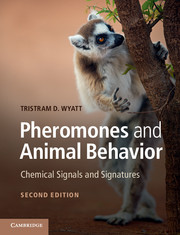Book contents
- Frontmatter
- Dedication
- Contents
- Preface to the second edition
- Acknowledgments
- List of SI prefixes
- List of Abbreviations
- 1 Animals in a chemical world
- 2 Methods for identifying and studying semiochemicals
- 3 Pheromones, chemical cues, and sexual selection
- 4 Coming together and keeping apart: aggregation pheromones and host-marking pheromones
- 5 Territorial behavior and semiochemicals
- 6 Semiochemicals and social organization
- 7 Pheromones and recruitment communication
- 8 Fight or flight: alarm pheromones and cues
- 9 Perception and response to chemical communication: from chemosensory receptors to brains, behavior, and development
- 10 Finding the source: pheromones and orientation behavior
- 11 Breaking the code: illicit signalers and receivers of semiochemicals
- 12 Using semiochemicals: applications of pheromones
- 13 On the scent of human attraction: human pheromones?
- Appendix An introduction to chemical terms for non-chemists
- References
- List of Credits
- Index
8 - Fight or flight: alarm pheromones and cues
Published online by Cambridge University Press: 05 June 2014
- Frontmatter
- Dedication
- Contents
- Preface to the second edition
- Acknowledgments
- List of SI prefixes
- List of Abbreviations
- 1 Animals in a chemical world
- 2 Methods for identifying and studying semiochemicals
- 3 Pheromones, chemical cues, and sexual selection
- 4 Coming together and keeping apart: aggregation pheromones and host-marking pheromones
- 5 Territorial behavior and semiochemicals
- 6 Semiochemicals and social organization
- 7 Pheromones and recruitment communication
- 8 Fight or flight: alarm pheromones and cues
- 9 Perception and response to chemical communication: from chemosensory receptors to brains, behavior, and development
- 10 Finding the source: pheromones and orientation behavior
- 11 Breaking the code: illicit signalers and receivers of semiochemicals
- 12 Using semiochemicals: applications of pheromones
- 13 On the scent of human attraction: human pheromones?
- Appendix An introduction to chemical terms for non-chemists
- References
- List of Credits
- Index
Summary
Alarm signals offer perhaps one of the greatest challenges to evolutionary explanations of behavior (Bradbury & Vehrencamp 2011). Why should animals make alarm signals, at potential risk to themselves, to warn conspecifics of danger? For many animal species that release alarm pheromones the answer is likely to be the benefits to kin, either direct family members or fellow members of a clone or social insect colony.
In social insects alarm pheromones are the most commonly produced class of chemical signal, after sex pheromones, and have evolved independently within all major taxa (Blum 1985). Like other pheromones, alarm pheromones are likely to have evolved as secondary or modified uses of existing compounds (Chapter 1). Two common evolutionary routes seem to be from either chemicals used in defense or those released by injury, both events being linked to predation.
A very different phenomenon, discussed in Box 8.1, is the evolution of alarm responses to cues of injury of unrelated conspecifics and even other species, found in a wide variety of aquatic organisms of all kinds (Ferrari et al. 2010; Wisenden 2014). These cues, sometimes called “public chemical information,” are not evolved signals (pheromones).
- Type
- Chapter
- Information
- Pheromones and Animal BehaviorChemical Signals and Signatures, pp. 165 - 172Publisher: Cambridge University PressPrint publication year: 2014
- 2
- Cited by



